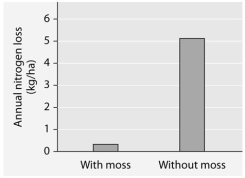Question 64
(Multiple Choice)
Researchers tested nitrogen loss from soil where the moss Polytrichum was growing,and compared it to soil from which Polytrichum had been removed.The data are presented below.

-Loss of soil nitrogen via "gaseous emission" was found to be negligible.Rather,most loss of soil nitrogen was due to water erosion of the soil.Which of these hypotheses is least likely to account for the observed results?
A)If rhizoids had helped stabilize the soil, then less erosion and less loss of nitrogen would occur.
B)If protonemata had absorbed, and stored, nitrogen from the soil, then they would have reduced loss of nitrogen by erosion.
C)If the overlying mat of gametophores had slowed the entry of water into the soil, then it would have reduced water's ability to erode the soil and carry away its nitrogen.
D)If sporophyte stomata had absorbed nitrogen from the soil, then they would have reduced loss of nitrogen by erosion.
Answer